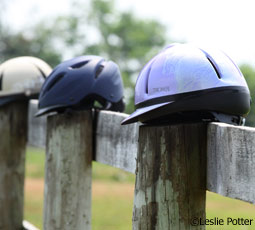
Two decades ago, if you needed a riding helmet, you went to the local tack shop and picked one out of a selection of nearly identical black velvet-covered hats. Today, riders have more choices than ever when it comes to buying protective headwear.
Find Your Style
The good news for traditionalists is that the classic black velvet look is still available. However, thanks to advances in design and technology, English riders have plenty of sophisticated and sporty options for both showing and schooling.
It’s taken some time for western riders to get on board with wearing helmets, but styles designed for the western market are helping to increase the appeal. Western design elements include leather-look coverings, conchos and decorative stitching.
A practical option for recreational riders is a basic schooling helmet. These helmets are typically more affordable than those marketed for competition use. They are lightweight and well-ventilated, making them ideal for summer trail riding or schooling sessions. You also have many color choices. Schooling helmets are acceptable to wear at lower-level shows of any discipline, so investing in one will fulfill most of your riding needs for as little as $30.
Whatever helmet style you choose, make sure it is labeled “ASTM/SEI approved.” This indicates that the helmet meets protective standards.
Get the Right Fit
Once you’ve found the right style, make sure you have the right fit. If your helmet puts too much pressure on any one part of your head, you’ll end your rides with a headache. Worse yet, if it’s too large and slides around, it may not protect you in a fall.
The shape of your head is just as important as its size when purchasing headwear. For this reason, it’s a good idea to try on a variety of brands and styles. If you find that a lot of helmets put pressure on your forehead, there are a few models available in a long oval shape that may be a better fit.
When you try on a helmet, wear your hair the way you do for riding, as that can have a significant effect on fit. Make sure the straps aren’t twisted and any fit mechanisms are open wide, then place the helmet on your head and tighten the straps so that they are snug, not dangling loosely. If it feels reasonably comfortable, the next test is to shake your head up and down and side to side. The helmet should not slide around at all.
Replacing Your Helmet
Modern helmets are much more effective than the simple plastic shells that riders wore until the late 20th century. Those old hunt caps could theoretically protect a rider’s skull from fracture, assuming they stayed put during a fall, but they didn’t do much to prevent concussions or brain injury.
The difference in today’s helmets is the foam lining that compresses upon impact. Concussions happen when the brain hits the inside of the skull. The helmet’s foam lining slows the speed of impact, bringing the head to a more gradual stop.
While the foam lining is lightweight and effective, the trade-off is that it doesn’t last forever. It degrades over time, especially if it’s kept in extreme heat or cold (for example, in the back seat of your car). Even if you store your helmet in a temperature-controlled room and out of direct sunlight, it will be less effective after about five years, and you’ll need to replace it. If your helmet is involved in an impact, such as a fall or even an accidental drop on a concrete barn aisle, the foam is compressed at the point of impact and won’t be as effective. This is also a reason not to buy a used helmet.
Many manufacturers offer discounts if you return your damaged helmet when you purchase a replacement. When you bring home your new helmet, check the tags and documents that come in the box for information about a replacement program. Otherwise, visit the manufacturer’s website or call the customer service number.
Invest some time in your search for the perfect helmet and you’ll be rewarded with many safe and stylish hours in the saddle.
Further Reading
Leslie Potter wears her fashionable pink schooling helmet every time she rides her Morgan gelding, Snoopy.
This article originally appeared in the 2013 issue of Your New Horse. Click here to purchase the most recent issue.





